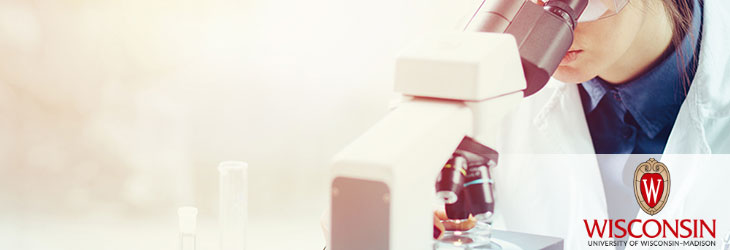Analytical Instrumentation, Methods & Materials

Gas Phase Sample Preparation For Cryo-Electron Microscopy
WARF: P170235US02
Inventors: Joshua Coon, Michael Westphall
The Wisconsin Alumni Research Foundation is seeking commercial partners interested in developing a new cryo-electron microscopy (cryo-EM) sample preparation method that addresses the limitations of current preparation methods. The new technology uses mass spectrometry to purify proteins and protein complexes.
Overview
Single particle cryo-electron microscopy (cryo-EM) is a powerful tool for providing 3-D structural information on non-crystalline specimens. Cryo-EM approaches atomic level resolution, enabling many new biological discoveries. Unfortunately, this technique still has several limitations, primarily due to sample preparation, which requires purification and vitrification to protect the samples from radiation damage.
At present, sample preparation generally involves solubilization of protein analytes in water, followed by pipetting onto a hydrophilic EM grid. The grid is blotted with filter paper (removing >99.99% of the sample) and then plunged into a bath of cryogen, vitrifying the remaining water/sample. This sample preparation method imparts a preferred orientation of the particles, due largely to particle migration to the air/water interface. This destroys the required structural heterogeneity. In addition, existing preparation methods limit particle density within the grids, resulting in extended data acquisition times and huge data files (5+ Tb).
At present, sample preparation generally involves solubilization of protein analytes in water, followed by pipetting onto a hydrophilic EM grid. The grid is blotted with filter paper (removing >99.99% of the sample) and then plunged into a bath of cryogen, vitrifying the remaining water/sample. This sample preparation method imparts a preferred orientation of the particles, due largely to particle migration to the air/water interface. This destroys the required structural heterogeneity. In addition, existing preparation methods limit particle density within the grids, resulting in extended data acquisition times and huge data files (5+ Tb).
The Invention
UW-Madison researchers have developed a novel cryo-EM sample preparation method that uses mass spectrometry to purify proteins and protein complexes in the gas-phase for subsequent in vacuo vitrification. Samples prepared in this way are extracted from the mass spectrometer using a cryo-transfer sample holder and placed directly into the EM for imaging. One implementation of this method includes the use of a modified quadrupole linear ion trap mass spectrometer that allows for the axial ejection of protein ions. The ions pass over a cooled sample probe where they are deposited onto an EM grid and vitrified. Formation of the ice layer is independent of the sample, thus allowing for the generation of uniformly thick ice. Further, any imperfection in the ice can be corrected using ion milling or related techniques.
Applications
- Single particle cryo-electron microscopy. Applications for cryo-EM include structural studies of eukaryotic cells, proteins and macromolecular complexes such as liposomes, organelles and viruses.
Key Benefits
- Increased image resolution
- Decreased image acquisition time
- Increased sensitivity
Additional Information
For More Information About the Inventors
Publications
- Thompson, R.F., An introduction to sample preparation and imaging by cryo-electron
Tech Fields
For current licensing status, please contact Jennifer Gottwald at [javascript protected email address] or 608-960-9854